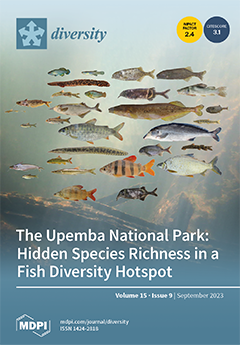Balsaminaceae are world-famous ornamental flowers because of their high species diversity, rich variation, peculiar flower patterns, and long ornamental cycles. To study the species diversity, distribution patterns, and distribution hotspots of Balsaminaceae in China, we updated the list of Balsaminaceae by systematically searching
[...] Read more.
Balsaminaceae are world-famous ornamental flowers because of their high species diversity, rich variation, peculiar flower patterns, and long ornamental cycles. To study the species diversity, distribution patterns, and distribution hotspots of Balsaminaceae in China, we updated the list of Balsaminaceae by systematically searching the related literature. The distribution pattern and hotspots of
Impatiens spp. were analyzed using the ArcGIS 10.8.2 software. Combining 19 meteorological factors and one elevation factor, the Maxent model was applied to analyze the dominant environmental factors that govern the distribution of
Impatiens spp. As of February 2023, Balsaminaceae in China included 360 taxa in two genera, including one taxon in the genus of
Hydrocera, 359 taxa in the genus
Impatiens, 271 national endemic species, and 157 provincial endemic species.
Impatiens spp. showed a diffusion pattern from the tropical and subtropical regions to the high-latitude and high-elevation regions concentrated in Southwest China, especially in the Hengduan Mountains in the broad sense, Southern Tibet, the Yunnan–Guizhou–Guangxi karst region, the Qinling–Daba Mountains, and the southeastern hills. The highest species richness was found in the 1200~1500 m elevation range, with 164 species of
Impatiens spp. This high species richness was maintained at between 900 and 2700 m, the elevation range where
Impatiens spp. are concentrated. When 100% of the species were screened out, 110 hotspots were found, including Southeast Yunnan, Northwest Yunnan, Southern Tibet, and Western Sichuan, where most of the hotspots were concentrated and overlapped with global biodiversity centers, but other hotspots were more scattered. Annual precipitation, the minimal temperature of the coldest month, the altitude and temperature annual range, and four environmental variables with a cumulative contribution of 93.7% were the dominant environmental factors affecting the distribution of
Impatiens spp. in China. This study lays the foundation for subsequent studies of Balsaminaceae diversity and is conducive to the development and use of
Impatiens spp. resources.
Full article





